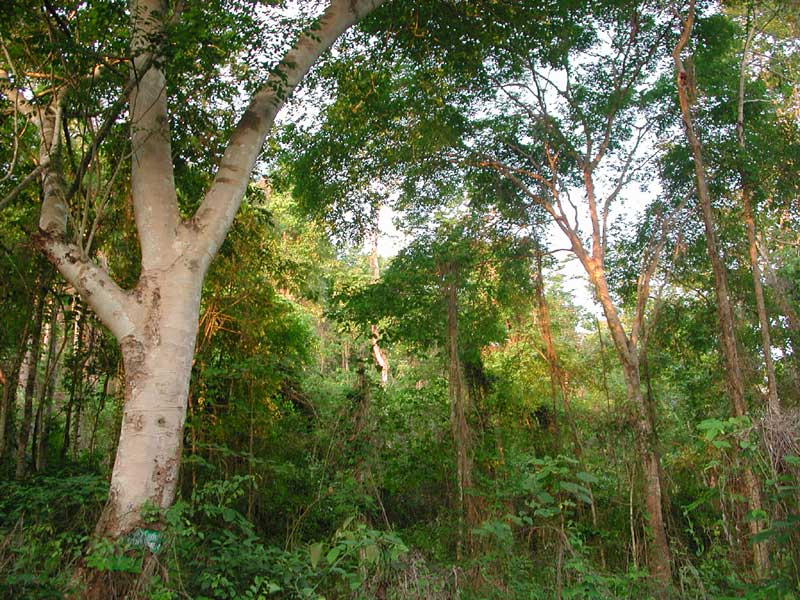VARIOUS TYPES OF FORESTS
-
Destruction of Forests
-
Consequences
QUIZ
Natural Vegetation refers to plants which grow by themselves.
WORLD'S DISTRIBUTION OF FORESTS
3 Types:
-
Forest vegetation
-
Grassland
-
Desert vegetation
VARIOUS TYPES OF FORESTS
1. TROPICAL RAINFOREST [Back to top]
Layers of rainforest
Ä 5 layers
|
Emergent
|
|
|
Canopy |
|
|
Understorey |
|
|
Shrub
|
|
|
Ground |
Pic source: http://www.wimeuverman.nl/images/rainforest.JPG
Information
-
Found in areas with high temperature and high rainfall.
-
Has many species (400 species per hectare).
-
5 layers: emergent, canopy, understorey, shrub and ground.
-
Emergent layer: 50m in height - reach for sunlight
-
Canopy: 30m - absorbs most sunlight, and intercepts most rainfall; provides shade for forest floor.
-
Understorey: 20m - consists of young trees.
-
Shrub: made up of shrubs and small trees.
-
Ground: sparse undergrowth; have buttress roots to support weight of tall trees.
-
Trees have smooth barks.
-
Trees have parasitic plants (feed on trees) and non-parasitic plants (e.g. lianas)
Photo Gallery
-
Images of rainforest: Photos
-
Photos of Plants of the Rainforest - Pitcher plants
Fungi
Medicinal plants
CASE STUDY: AMAZON RAINFOREST
-
Indigenous Tribes of the Amazon Rainforest
Photos of the Amazonian Indian tribes -
Animals of the Rainforest: Photos
OVERVIEW
Good information about rainforest plants & animals, deforestation & conservation
2. MANGROVE FOREST [Back to top]
|
Pic source: http://www.pacificworlds.com/palau/sea/beaches.cfm |
Pic source: http://mbgnet.mobot.org/salt/sandy/mangroves.htm
|
Information
-
Vegetation grows along coastlines and along river banks in Southeast Asia.
-
Thrive in muddy and shallow waters.
-
Have broad leaves.
-
Have aerial root system - jut out from ground to take in oxygen.
-
Have stilt-like roots - anchor trees firmly to ground.
-
Animals in the mangroves - Photos
-
Plants in the mangroves - Photos
3. TROPICAL MONSOON FOREST [Back to top]
|
Pic source: http://www.oxfammekong.org/graphics_pages/land_and_forest/Photosthailand.htm |
Information
-
Found in areas with seasonal high temperature and high rainfall.
Trees are deciduous - trees shed leaves in dry season. -
Has many species (200-300 species per hectare) but less than that of tropical rainforest.
-
Tree grow in rainy, monsoon season.
-
Trees have thin leaves of varying sizes.
-
Three layers: Canopy, Shrub and Ground layer.
-
Undergrowth is thick/dense.
-
Tropical hardwood include teak and sandalwood.
4. TEMPERATE DECIDUOUS FOREST [Back to top]
|
Spring Pic source: http://www.treetures.com/gifs/sprig/Forests/Temperate1.jpg |
Autumn
|
Information
-
Deciduous - trees shed their leaves in the dry season.
-
Trees have rounded outline in summer and looks bare in winter.
-
Trees grow to a height of 20-40metres.
-
Have large crown and broad thin leaves.
-
Few species of trees (3-4 species per hectare)
-
Dense shrub area.
-
Thick/dense undergrowth.
5. TEMPERATE CONIFEROUS FOREST [Back to top]
|
Spring Pic source: http://www.kars.ukans.edu/forest/EASTFRK.gif |
Winter Pic source: http://www.dennisflood.com/photos/gallery/trees_winter.shtml |
Information
-
Evergreen trees.
-
Very few species (1-2 species per hectare)
-
Grow to height of between 30-40metres; pure stands.
-
Conical in shape - branches slope downwards to prevent accumulation of snow in winter.
-
Have needle-like leaves - reduce transpiration
-
Have woody cones - protect seeds in cold winter.
-
Sparse undergrowth.
FORESTS & US [Back to top]
Destruction of forests
-
Images of Deforestation: Photos
Consequences
-
Extinction of animal species: Photo 1, Photo 2, Photo 3 [Viewer Discretion is advised]
Gorillas, chimpanzees, and many other forest species are rapidly becoming in danger of extinction because of the explosion in the "bushmeat" trade due to logging opening up formerly remote forests.
A small number of gorillas, especially infants, are captured for sale abroad; others are killed and used in traditional medicine compounds. Laws to protect the gorilla exist but are often poorly enforced.
Excerpt of the documentary Bushmeat, followed by an interview with Dr. Kerry Bowman: Video of Bushmeat poaching and logging [Viewer Discretion is advised]








